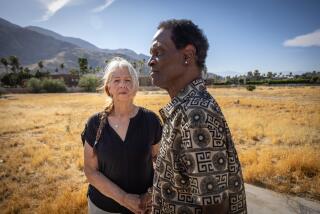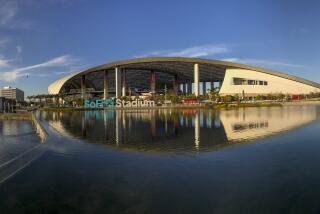Review: ‘The Pruitt-Igoe Myth’ builds from an implosion
- Share via
Forty years ago, an enormous, decrepit, crime-ridden St. Louis public housing project was destroyed with dynamite. Television and still pictures of the imploding buildings went viral, so to speak, though that wasn’t a term yet.
The death of the complex known as Pruitt-Igoe was seized on by any number of groups as validation of their viewpoints. Enemies of modern architecture said the soullessness of the design caused the problem. (Minoru Yamasaki, who went on to design the World Trade Center towers in New York, was the architect.) Conservatives said it demonstrated that government-sponsored housing inevitably collapses, or muttered that this was further proof that the poor were their own worst enemies, beyond the reach of state assistance of any kind.
Now, the housing project is the subject of a new documentary, “The Pruitt-Igoe Myth.” Director Chad Freidrichs, who co-wrote the film with his wife, Jamie, agrees that there are lessons to be learned from those St. Louis buildings — but not the ones everyone thought.
A well-researched and iconoclastic documentary that is both thoughtful and troubling, “The Pruitt-Igoe Myth” is indeed a cautionary tale, but what it cautions against is the lure of easy judgments derived from prejudices and ignorance of the facts.
There is little argument that by the time it was destroyed, the Pruitt-Igoe complex, which housed 26,000 people in 33 buildings on a 57-acre site, was in horrible shape, a haven for drug dealers and other criminals and a monument to the worst kind of decay and neglect. But it wasn’t always this way.
Chad Freidrichs tracked down eye-opening newsreel footage showing how beautiful the complex was when it opened in 1954. He interviewed several former residents whose memories of the early days of the project are at variance with the accepted narrative. “It was like an oasis in the desert,” one says, while another remembers a sense of “engaging, electric life.”
So what went wrong in 18 short years? The film puts the blame on a combination of factors, some specific to St. Louis, some characteristic of a great deal of 20th century life. Caught by forces beyond their control, the residents of these massive towers were used as scapegoats, blamed for broader urban trends afflicting cities nationwide.
The initial impulse behind the towers was the idea of using the public sector to help people escape from dreadful slums, and the business community had its own reasons for agreeing: Redeveloping the land would surely be a profitable enterprise.
But money to maintain the buildings was something else, and the compromises of politics ensured that public funds would not be used for upkeep. That decision proved to be the first nail in Pruitt-Igoe’s coffin.
The same Housing Act of 1949 that made Pruitt-Igoe possible also helped fund the growth in suburbia. That, along with the erosion of St. Louis’ industrial base, prompted middle-class whites to move out of the city, and jobs went with them.
So the Pruitt-Igoe buildings that everyone thought would be full were not, and rents that were to be used to pay maintenance costs were not there. Women and children on welfare moved in but, adding to the societal disintegration, draconian welfare rules forbade any men from living in a home where the woman received government assistance.
Once deterioration fed by lack of maintenance began, no one had the wherewithal to halt it, and stopgap measures like installing theoretically vandal-proof fixtures just incited the residents, who felt that the government did not trust them, creating a bitter, angry population.
The personal stories told by former residents add a poignancy to the broad trends the film examines. The tales include positive ones, such as a mother who couldn’t afford paper but painted one apartment wall black so her kids would be able to use it like a chalkboard to do homework. Then there was another resident’s sadness as he remembered thinking at the time, “Why is it like this? Why do I live here? What did I do wrong?”
As we head into a presidential election in which blame for all manner of ills is going to be freely apportioned, it’s good to have this timely reminder that the truth behind the myth is often as compelling as it is hard to find.
More to Read
The biggest entertainment stories
Get our big stories about Hollywood, film, television, music, arts, culture and more right in your inbox as soon as they publish.
You may occasionally receive promotional content from the Los Angeles Times.











